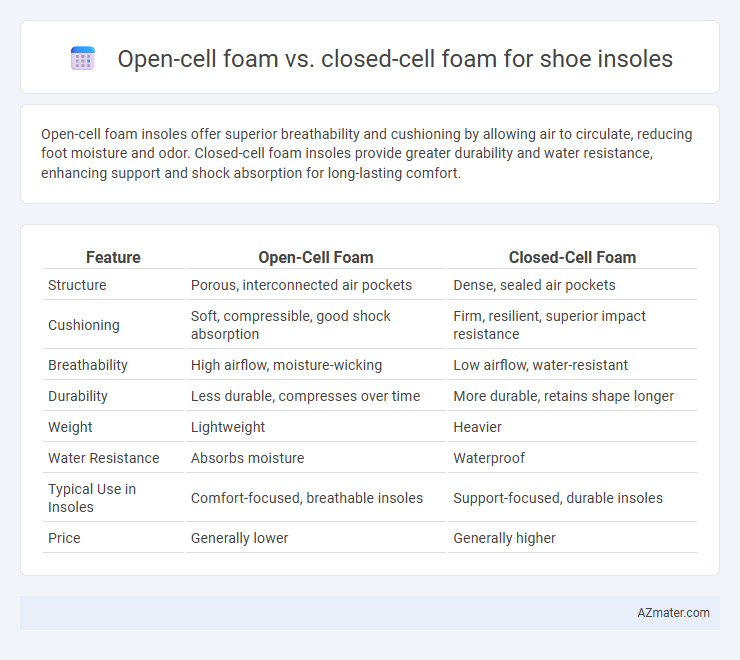Open-cell foam insoles offer superior breathability and cushioning by allowing air to circulate, reducing foot moisture and odor. Closed-cell foam insoles provide greater durability and water resistance, enhancing support and shock absorption for long-lasting comfort.
Table of Comparison
| Feature | Open-Cell Foam | Closed-Cell Foam |
|---|---|---|
| Structure | Porous, interconnected air pockets | Dense, sealed air pockets |
| Cushioning | Soft, compressible, good shock absorption | Firm, resilient, superior impact resistance |
| Breathability | High airflow, moisture-wicking | Low airflow, water-resistant |
| Durability | Less durable, compresses over time | More durable, retains shape longer |
| Weight | Lightweight | Heavier |
| Water Resistance | Absorbs moisture | Waterproof |
| Typical Use in Insoles | Comfort-focused, breathable insoles | Support-focused, durable insoles |
| Price | Generally lower | Generally higher |
Introduction to Shoe Insole Foams
Open-cell foam and closed-cell foam are two primary materials used in shoe insoles, each offering distinct structural and comfort benefits. Open-cell foam features interconnected air pockets, providing superior breathability and cushioning ideal for moisture control and comfort in active footwear. Closed-cell foam consists of tightly packed cells that prevent water absorption and offer enhanced durability and shock absorption, making it suitable for long-lasting support and protection in varied shoe designs.
What is Open-cell Foam?
Open-cell foam consists of interconnected cells that allow air and moisture to pass through, providing breathability and cushioning in shoe insoles. Its porous structure enables better shock absorption and moisture-wicking properties, enhancing comfort during prolonged wear. Compared to closed-cell foam, open-cell foam offers superior ventilation but generally less water resistance and durability.
What is Closed-cell Foam?
Closed-cell foam is a dense, durable material characterized by its tightly packed cells that are impermeable to water, air, and moisture. This type of foam provides excellent support and shock absorption in shoe insoles, offering superior stability and long-lasting cushioning compared to open-cell foam. Its resistance to compression and moisture makes it ideal for athletic footwear and environments requiring enhanced durability and protection.
Key Differences: Open-cell vs Closed-cell Foam
Open-cell foam in shoe insoles offers superior breathability and flexibility due to its interconnected pores, making it ideal for moisture management and comfort during extended wear. Closed-cell foam provides higher density, increased durability, and better water resistance, ensuring enhanced support and longevity in footwear applications. The primary distinction lies in open-cell foam's softness and airflow capabilities versus closed-cell foam's rigidity and moisture barrier properties.
Comfort and Cushioning Comparison
Open-cell foam insoles offer superior breathability and moisture-wicking properties, enhancing comfort during extended wear by preventing heat buildup and sweat accumulation. Closed-cell foam insoles provide denser cushioning with higher shock absorption and durability, maintaining shape under pressure and offering better support for high-impact activities. Choosing between the two depends on whether priority lies in ventilation and softness or resilience and protective cushioning.
Breathability and Moisture Control
Open-cell foam offers superior breathability due to its porous structure, allowing air to circulate freely and helping to keep feet cool during extended wear. Closed-cell foam provides better moisture control by preventing water absorption and retaining less sweat, thereby maintaining a drier environment inside the shoe. For shoe insoles, combining open-cell foam's ventilation with closed-cell foam's moisture resistance can optimize overall foot comfort and hygiene.
Durability and Longevity
Closed-cell foam insoles offer superior durability and longevity due to their dense structure that resists compression and moisture absorption, making them ideal for long-term use in shoes. Open-cell foam insoles, while softer and more breathable, tend to degrade faster as they absorb sweat and break down under repeated pressure. For extended wear and lasting support, closed-cell foam outperforms open-cell foam by maintaining cushioning and structural integrity over time.
Weight and Flexibility Factors
Open-cell foam insoles weigh less and provide superior flexibility, enhancing comfort and adaptability for dynamic foot movement in shoes. Closed-cell foam insoles are denser and heavier but offer increased durability and support, making them ideal for impact absorption and long-lasting wear. The choice between the two depends on the desired balance of lightweight comfort versus robust structural support in footwear design.
Ideal Applications in Footwear
Open-cell foam in shoe insoles offers excellent breathability and cushioning, making it ideal for athletic and casual footwear where moisture management and comfort are prioritized. Closed-cell foam provides superior support, water resistance, and durability, well-suited for hiking boots and work shoes requiring impact protection and structural stability. Choosing between these foam types depends on activity level and environment, with open-cell favored for ventilation and closed-cell for robust, long-lasting support.
Choosing the Right Foam for Your Insoles
Open-cell foam offers superior breathability and cushioning, making it ideal for those seeking enhanced comfort and moisture management in shoe insoles. Closed-cell foam provides greater durability and moisture resistance, supporting long-term use and improved structural support. Selecting the right foam depends on prioritizing breathability versus durability, with open-cell suited for ventilation and softer comfort, while closed-cell excels in impact absorption and water resistance.

Infographic: Open-cell foam vs Closed-cell foam for Shoe insole
 azmater.com
azmater.com